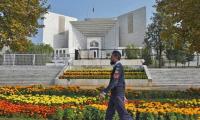Why has Fata literally remained the ‘Federally Administered Tribal Areas’ for so long? What has prevented the government from mainstreaming Fata? Are just the people there responsible for the present state of affairs? Will the fate of people there ever change for the good?
I would like to emphasise at the outset that the people of Fata are not solely responsible for what has happened or is still happening in that area. There is no doubt that the people there preferred to maintain their somewhat quasi-independent status. The reason was that nobody there wanted to disturb the existing order/equilibrium of society based on the centuries-old tribal code, customs and traditions. The system was old but it worked perfectly well in the tribal environment; perhaps better than in other parts of the country. For example the crime rate there was far less than that in the settled area. It was only when the system was demolished the process of nurturing ‘strategic assets’ that things nose-dived for the worse.
But it would be completely wrong to assert that the tribals shunned development and therefore they were disregarded in this process. On the contrary, all tribals – without exception – have always looked forward to development as it would open up more avenues of better livelihood and also a better future for their children. At the time of Partition they were as backward or less developed as some parts of Balochistan, Sindh or Punjab.
With independence hopes were high among the tribals that their future would also change for the better. They thought that in the same manner that their erstwhile British masters had laid a network of roads, airports, railways etc in the other parts of the country, now their very own government would develop Fata like other backward areas in other provinces of Pakistan. They felt Fata would also be included in different projects that were implemented, over the years, for the uplift of certain areas in the country. Sadly their hopes were dashed and not an iota of change took place either in terms of development or governance in the area. It was all business as before. The only difference was that while earlier the redcoats ordered them around, now it was the brown sahibs ruling the roost. As far as the people of Fata were concerned, they only exchanged masters.
Since the creation of Pakistan the people of Fata have had no role, whatsoever, in the governance of the area. That role was taken over by outsiders which is why Fata remained backward and eventually became a hotbed of militancy. Fata has always been administered by the federal government through its civil servants, who as exclusive masters managed the area till the invasion of Afghanistan by the Americans in 2001, prompting the then dictator Gen Musharraf to deploy the army in Fata; this could have been avoided had he consulted saner elements in the area.
The armed forces have been in the area since then. Neither before nor after the arrival of the armed forces in the area were the people of Fata ever involved in running the affairs of their own area.
Fata has been used and abused by all. But the last two dictators of the country take the cake for having done the worst possible damage to the tribal areas, and thereby, to the rest of the county as well. All that just to prolong their rule and gain acceptance by the West by serving its interests without any regard for how much the country suffered as a consequence. Ziaul Haq did that by using Fata as a launching pad for jihad in Afghanistan and Musharraf did it by siding with the US in the so-called war on terror. In addition, Musharraf also provided safe havens to militants – something he admitted in a recent TV interview. According to him this was done for settling scores with Hamid Karzai.
When Pakistan came into being there was optimism that the rights of Fata residents usurped under the notorious Frontier Crimes Regulations, meant to keep them under the colonial heel, would be restored. But the rulers of the time decided to retain the FCR instead of scrapping it altogether. They continued to follow the colonial policy of using Fata as a buffer zone against Afghanistan so the area was deliberately kept isolated and delinked from the rest of the country. Even now outsiders, despite being fellow Pakistanis, are not allowed to visit Fata without prior approval of the government.
Journalists are personae non gratae when it comes to Fata. When pressure mounts too much they are allowed in but are allowed entry to only certain areas. Independent media reporting is non-existent and not permissible. Local journalists have either been killed by unknown people or have migrated to other areas in the settled districts of the country.
Efforts are now underway to clean up the mess made in the tribal areas or at least to reverse the tide but a lot of water has flown under the bridge and the task does not appear to be easy without a paradigm shift. It also requires empowering the people of Fata so that they can handle all matters themselves including the menace of militancy in the area. The people of Fata have for long been seeking restoration of civil rights equal to those that citizens in other parts of the country enjoy.
Of the twenty-point agenda of the National Action Plan the most important one happens to be the mainstreaming and development of Fata. Although it has not yet seen the light of day, the government has appointed a five-member committee which has so far held meetings with Maliks in the Bajaur and Mohmand agencies in addition to meetings with others at Governor House, Peshawar. From this it appears that the government is not really in favour of empowering the tribes-people but simply intends to introduce some cosmetic changes at the grassroots level so that the incumbent representatives of the federal government can continue to govern Fata as before. This will certainly get the support of Maliks and other allowance/benefit holders but not that of the vast majority of people.
What the people there want is a provincial status for Fata where they can have a government of their own similar to elsewhere in the four provinces of the country; that or a merger with Khyber Pakhtunkhwa.
The merger with KP should have a grace period of 5-10 years and allocation of reasonable amount of money coupled with a comprehensive plan to develop Fata and bring it at par with KP within a specified period. It may, however, be kept in mind that development of Fata will be possible only if that responsibility is entrusted to the people of Fata with one amongst them at the helm of affairs to ensure speedy and proper execution of all projects within the stipulated time frame.
The key for resolution of Fata’s problem lies with the government and must be used very carefully or else it will be a futile exercise and Fata will remain as backward as it is with all the existing problems continuing to worsen.
The writer is a former ambassador. Email: waziruk@hotmail.com
Pakistan has been sending its cricket team to India despite bilateral tension in past, proving to be responsible country
Despite multiple bailouts, Pakistan remains mired in inflation, debt, and stagnation
Govt should prioritise developing public transport solutions that are both sustainable and use technology with low...
During turbulent years before and after 2010, Bilour family stood out for sacrifices, paying in blood for their...
Lahore, city of 14 million people, has – again – topped rankings of world’s most polluted air
Over 50% of Pakistan’s cigarette market is controlled by illegal manufacturers who evade taxes







